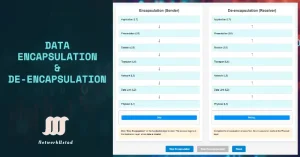Understanding Data Encapsulation and Decapsulation in OSI Layers: A Comprehensive Guide With Simulator Updated 2025
Data encapsulation and de-encapsulation are crucial for transmitting information across computer networks. Encapsulation involves wrapping data in a specific format before sending it over the network, ensuring it can traverse various communication mediums and reach its destination intact. On the other hand, de-encapsulation is the process of unwrapping and extracting the original data at the […]

